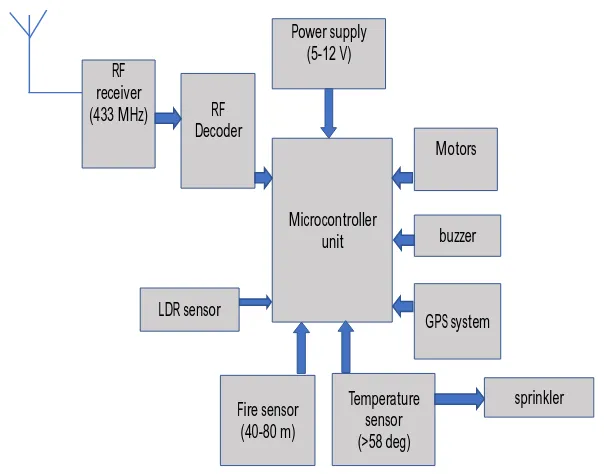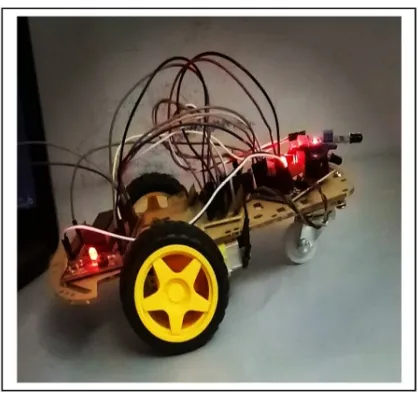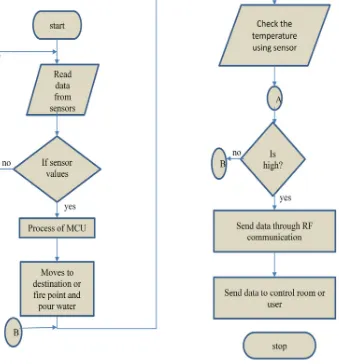Fire Fighting Robot
Sharini D L
1, Sapna Prabhu G
2, Premchand M
3, Tejesh Kumar
4, Praveen Kumar M
51, 2, 3, 4UG Students, Department of Electronics & Communication ,Sahyadri College of Engineering & Management, Mangaluru,
India
5Assistant Professor, Department of Electronics and Communication, Sahyadri College of Engineering and Management,
Mangaluru, India
Abstract: As per the recent technology , Robots take the place of humans in almost all the fields. Our aim is to design the robot capable of detecting fire and suppressing it. We hereby are trying to design and implement an autonomous robot capable of detecting and extinguishing flames ,disasters can be avoided within minimal risk of human life. It also involves the obstacle avoidance , GPS and GSM modules in cooperated within this robot.
Keywords: CO2, IDE, Autonomous, Microcontroller, Extinguisher
I. INTRODUCTION
Chemical process that releases heat, light and other various other products is known as fire. At some point of the reaction, flames are produced ,flames generally consist of CO2, water vapor ,nitrogen and oxygen .Fire is a process which is important in affecting ecological system. Thus fire has both positive and negative impacts. Positive impacts may include simultaneously growth and maintenance of various ecological systems. Similarly negative effects may include hazard to life and property, pollution, removal of vegetation ,loss of nitrogen in the soil etc. There are different classes of fire such as Class A, Class B, Class C, Class D, Class E. Here, we are mainly concentrating on Class A, Class E, Class B forms of fire. The robot provides protection from any kind of fire accidents, it avoids electrical hazards since it makes use of CO2 for extinguisher. The robot has a range of about 2-3kms. Since it makes use of GPS and GSM technology, the robot can be used during massive fire accidents to send a message to the near by service station. The robot is compatible with all the classes of fire and is human friendly
II. LITERATURESURVEY
III.METHODOLOGY
The fire-fighting robot designed in this paper is compatible with class A ,B ,C ,D and E .It makes use of CO2 cartridge to extinguish the flame, the cartridge is mounted on the robot which discharges when fire is detected. It is done by attaching a servo motor to the leveler to discharge the cartridge. The robot has a field view of 180 degree to detect flames with obstacle avoidance and maneuver in the surroundings. It makes use of different kinds of sensors .The flame sensors are placed 60 degree apart in order to achieve 18 degree field view. The robot also consist of GPS systems which on receiving proper signals, sends a message with a near by fire station as well as to the person in concern to it.
[image:2.595.143.445.224.461.2]A. Hardware Implementation
Fig A: Hardware block diagram
The four wheeled differential drive robot with desired mobility and speed is used for this application. The microcontroller is used to read analog and digital values sensed from the sensor and also to send control signals to the motor controller board. In order to generate a PWM signal, to control a servo motor attached to the robot tire inflator to discharge CO2. Thus it can be achieved by mounting a suitable servo motors arm to control the inflator. This can be mounted on existing differential drive robot. By turning the servo motor on, the CO2 can be discharged from the cartridge. It is noted that a high torque servo motor such as HS5685 should be used to discharge CO2. The flame sensor produces an output i.e., digital and analog signal, in order to obtain higher accuracy we use the ADC to read analog signals instead of digital values.
There are three flame sensors used with the detection angle of total 180 degree with each sensor having detection angle of 60 degree. The flame sensor operates from 5V-3.3V. its detection range varies from 20-100cm. the distance increases with increase in this flame intensity. The output from the ultrasonic sensor is used to find distance between the robot and the obstacle along with interfacing microcontroller.
As shown in the fig A, the block diagram is modified from Bluetooth to GPS & GSM communication. This also provides us with sufficient data, not only avoid the obstacles but also to maintain a safe distance between fire source and extinguish the fire. The GPS receiver gets the signal from GPS satellite. It transmits an exact time when the signals are sent. The GPS receiver can determine the position in three dimensions, east, north, altitude. Here GPS itself does not require an internet connection but it makes use of MAPS app. Other than flame sensor there is an ultrasonic sensor which is mounted on the servo motor to pan the surroundings in order to choose a optimum path when it encounters an obstacle or fire.
Microcontroller unit Power supply
(5-12 V) RF
receiver
(433 MHz) RF
Decoder
Motors
Temperature sensor (>58 deg) LDR sensor
sprinkler buzzer
GPS system
Fig B: Hardware circuit diagram
As shown in fig B, the robot consist of PIC16F876 microcontroller, flame sensors, ultrasonic sensors, infrared sensors, smoke sensor, smoke cartridge, motor drivers, buzzer.
Fig C: Prototype
B. Software Implementation
The microcontroller is programmed using Micro Pro C. Once the robot is powered on, it will initialise a digital I/O pin as an output in order to send control signals to ultrasonic distance sensor. The ultrasonic sensor returns a pulse whose duration is equal to time taken for the ultrasonic pulse to travel from sensor to the object and reflect it back. This pulse is sent back to the I/O pin of the sensor. Hence the digital I/O pin should be made as input in order to read this input pulse. The pulse duration is received for the wave to propagate from sensor to the object and back again. Here we divide pulse duration by 2.
[image:3.595.56.265.415.614.2]Once the distance is computed compare it to a pre-set threshold value. Here pre-set threshold value is a safe distance the robot maintains from an object. This value can be obtained trail and error method. In case if the measure distance is more than threshold, the robot continues to move. forward. If the distance measured is less the servo motor to which UV sensor is mounted is controlled by sending PWM signals. The sensor is moved left to right to measure the least obstacle path.
Fig D: Software flow chart
From the fig D, initially after initialising the variables the sensor reads the data and if the value is satisfied then the command is sent to the MCU unit or else the process is repeated. The output from the MCU is given to the motor driver in order to determine the direction. The temperature sensor senses the value, if condition is satisfied it sends the data to RF communication. Once the output of RF communication is processed, the output reaches the user or the control room. Hence after completing these process, the program control is terminated.
IV.CONCLUSION
REFERENCES
[1] E. Krasnov and D. Bagaev, "Conceptual analysis of firefighting robots' control systems," 2002 IV International Conference "Problems of Cybernetics and Informatics" (PCI), Baku, 2002, pp. 1-3.
[2] M.Azegami and H. Fujixoshi, "A Systematic Approach to Intelligent Building Design," IEEE Communications Magazine, October 2004, pp.46-48.
[3] H. Kobayashi, M. Yanagida, "Moving object detection by an autonomous guard robot," Proceedings of the 4th IEEE International Workshop on Robot and Human Communication, 2004, TOKYO, pp.323-326.
[4] Sung-On Lee, Young-Jo Cho, Myung Hwang-Bo, Bum-Jae You, Sang-Rok Oh , "A stable target-tracking control for unicycle mobile robots," Proceedings of the IEEE/RSJ International Conference on Intelligent Robots and Systems 2004, TOKYO, pp.313-316.
[5] M. Li-xin, S. Dao-nian, C. Min-xuan, and W. Xiao-qin, “Application of Intelligent PID Control for Robot”, IEEE Conference on Cybernetics and Intelligent Systems, pp. 455-458, 21-24 Sept. 2006.
[6] R. C. Luo, K. L. Su and K. H. Tsai, "Intelligent Security Robot Fire Detection System Using Adaptive Sensory Fusion Method," The IEEE International Conference on Industrial Electronics Society ,2008 (IECON 2008), pp.2663-2668.
[7] Tong feng , Xu Lufeng , Tong Daoling, “An ultrasonic obstacle avoidance system for fire fighting robot” Proceedings of the 4th World Congress on Intelligent Control and Automation,pp 1219 - 1222 vol.2, 2010.
[8] T. L. Chien, H. Guo, K. L. Su and S. V. Shiau, "Develop a Multiple Interface Based Fire Fighting Robot," 2011 IEEE International Conference on Mechatronics, Kumamoto, 2011, pp. 1-6.
[9] Healey, G., Slater, D., Lin, T., Drda, B. Goedeke and A. D., "A system for real-time fire detection," in Proceedings of IEEE Computer Society Conference on Computer Vision and Pattern Recognition, 2014, pp. 605-606.


